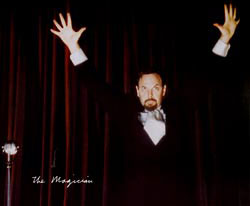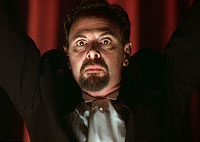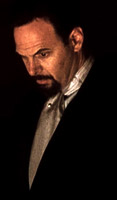Magician![]() RichardGreen
RichardGreen
|
Sex |
|
Male |
Quotes: |
|
Age |
Middle 40s |
||
|
Address |
Club Silencio |
||
|
Occupation |
Magician |
||
|
Fashion style |
Wand |
||
|
Doppelganger |
Abuser?, Lynch himself? |
"The primary theme of the scene in Club Silencio is Illusion. As such, it's not accidental that a magician is the first person Betty and Rita see on stage. The magician understands that everything here is an illusion - illusions are, after all, the stock of his trade."
 In Club Silencio,
the Magician looks at the audience and says, "… it's all an illusion,
listen!" We hear thunder and see blue lightning, which prompts Betty to
start shaking profusely (as if finally forced to wake up from the dream). It
seems like the Magician is causing the thunder, and he appears to be staring right at
Betty while she shakes. The thunder then stops, along with Betty's shaking.
The Magician gives Betty one more "evil" stare, grins, and then disappears in a
cloud of smoke. We then see a lone microphone standing in the middle of the
stage, the same one that comes out at the very end of the movie, right before
the "Silencio" scene with the blue haired women.
In Club Silencio,
the Magician looks at the audience and says, "… it's all an illusion,
listen!" We hear thunder and see blue lightning, which prompts Betty to
start shaking profusely (as if finally forced to wake up from the dream). It
seems like the Magician is causing the thunder, and he appears to be staring right at
Betty while she shakes. The thunder then stops, along with Betty's shaking.
The Magician gives Betty one more "evil" stare, grins, and then disappears in a
cloud of smoke. We then see a lone microphone standing in the middle of the
stage, the same one that comes out at the very end of the movie, right before
the "Silencio" scene with the blue haired women.
I believe that just before the Magician disappears, he causes the blue box to appear in Betty's purse, although we don't see it until Rebekah sings. Perhaps the "evil" Magician represents the person behind Winkie's (Lynch uses the same type of lighting in both scenes) who is slowly forcing Betty/Diane to face the reality of what she has done (also what she has become), as represented by what's inside the blue box. Towards the end of the film when we see the "monster/bum" place the blue box in the brown paper bag, perhaps it represents the Magician placing the box in Betty's purse. The moment Betty/Diane takes the blue box out of her purse, metaphorically, the truth is "let out of the bag." The box becomes the last piece of the puzzle. When Diane is faced with the reality of what she has done and the people she has hurt (including herself and her family), suicide is the only answer, hence "Silencio". - (humanist)
The Devil?
 I believe the
Magician is the Devil, or Diane's perception of the Devil. He is actually a
pretty silly Hollywood stereotype of the Devil, just as the Cowboy is a silly
stereotype. The Magician speaks at least three languages. The Devil's many
tongues is a frequent description of him. He has a goatee like most of the
standard, stereotypical depictions of him. He has a large wand which could act
as his pitchfork. He can perform magic. And, well, his grin as he disappears
behind smoke doesn't exactly say, "Nice to see you. How're your
folks?" - (Mark Beers)
I believe the
Magician is the Devil, or Diane's perception of the Devil. He is actually a
pretty silly Hollywood stereotype of the Devil, just as the Cowboy is a silly
stereotype. The Magician speaks at least three languages. The Devil's many
tongues is a frequent description of him. He has a goatee like most of the
standard, stereotypical depictions of him. He has a large wand which could act
as his pitchfork. He can perform magic. And, well, his grin as he disappears
behind smoke doesn't exactly say, "Nice to see you. How're your
folks?" - (Mark Beers)
Related: Hell sign on Sunset Blvd.
 The
magician representing the abuser
The
magician representing the abuser
At the end of the magician's performance, he emphatically tells us to "Listen!" Then, as flashes of lightning and peals of thunder fill the theater, Betty's body gets tense and starts shaking uncontrollably. While she does this, the magician's face looks like he is straining, and he is somewhat tense as well. And then, suddenly there is the sound of a man making a grunting sound, like he is releasing something pent up inside of him. Then the magician relaxes with an evil grin on his face, as Betty also relaxes finally, looking unsure of what just happened. Next, in a cloud of smoke the magician vanishes.
I believe that this last revelation from the magician was sexual in nature. The magician was forcing Diane to relive how her Betty-like innocence was lost long ago when she had been raped as a child.
- (Alan Shaw)
Related: Sexual Abuse
Trivia
-
Richard Green is a filmmaker and producer of the Jack Nance documentary "I Don't Know Jack". His association with Lynch dates back to the Eraserhead days. Green then lost touch with Lynch, only seeing him again at Jack Nance's funeral in early 1997 where they discussed a character, Abraxor the Magician, that Green had developed for a gig at a San Francisco fair. Two years later Green received a call during the shooting of Mulholland Dr. "David called me on a Friday," says Green, "and wanted to shoot the scene on the following Monday. It turned out to be one of the greatest days of my life."
-
As for his performance as Lynch's magician-of-the-moment, Green remains dazzled by the experience. "Personally," he admits, "I think my line in Mulholland is the key to the movie – There is no band, the whole thing's an illusion." Leave it to a prestidigitator to summarize Lynch's weird, wooly relationship to the meanings of things in his movies as nothing less than a false-bottomed box, custom-built for an astonishing, elusive and metaphysical disappearing act.
-
Richard Green about his role and some set trivia:
It's definitely called "The Magician" in the script and on the credits. Yet the character isn't so much of a magician as more a malevolent master of ceremonies who tells you what you will see and what you won't see. Things like the appearing cane is an old gag of mine which David dug.
I think, the scene does signal the shift to where Naomi Watts' personal insanity starts playing out in the outside world. Up until that point there's nothing really weird that happens to the two of them - with the exception of the dead body."
 "David included my prep (where
the actor psyches himself up at the last moment before the camera rolls). That
first moment of me standing there for a couple of seconds was shot before I knew
we were rolling. I was doing my prep, getting ready to go, then I heard,
"Action!" and then I moved. I was surprised to see it, to be honest."
"David included my prep (where
the actor psyches himself up at the last moment before the camera rolls). That
first moment of me standing there for a couple of seconds was shot before I knew
we were rolling. I was doing my prep, getting ready to go, then I heard,
"Action!" and then I moved. I was surprised to see it, to be honest."
"At the time we shot it I had no context because David would not let me read the script. So I didn't know. I understood it would be the ending of the original movie concept. An interesting side note: David had me go to a creature factory - one of the places that makes rubber masks and body pieces for Hollywood - and they did an upper-body cast of me. The gag was supposed to be that, at the end of the scene where I give that arch look and there's blue light, I was supposed to burst into flame. The first time I saw the film I thought, "What happened?" I never asked David about it, but thinking that if they had cut to the dummy they wouldn't have had that long, lingering look which is so portentous at that moment in the film."
"I knew that this was one of the best things I had ever
done and one of the most fun experiences I had ever had. It was a time in my life where I felt like I was part of the director and the director was part
of my performance - we were so locked. But then seeing David's visualization of it, from the outside, presented
a whole different world. It didn't look different, it didn't seem like a different place. I just realized how beautiful - how majestic - the place was, how he captured what we did that day."
Richard Green in Wrapped in Plastic #57
|
Related: |
Thread: "Bondar" the Magician? - (blu) Link: Other Green Worlds (filmmakermagazine.com) |